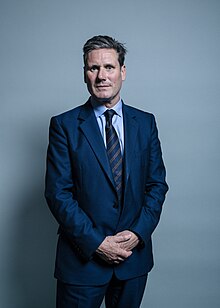
Back زعيم حزب العمال (المملكة المتحدة) Arabic Ηγέτης του Εργατικού Κόμματος (Ηνωμένο Βασίλειο) Greek رهبر حزب کارگر بریتانیا Persian Chef du Parti travailliste (Royaume-Uni) French מנהיג מפלגת הלייבור (הממלכה המאוחדת) HE Liderzy brytyjskiej Partii Pracy Polish Список лидеров Лейбористской партии Великобритании Russian Leader of the Labour Party (UK) SIMPLE 工党党魁 (英国) Chinese
| Leader of the Labour Party | |
|---|---|
| Status | Party leader |
| Member of | National Executive Committee |
| Precursor | Chair of the PLP |
| Inaugural holder | Keir Hardie |
| Formation | 17 January 1906 |
| Deputy | Deputy Leader of the Labour Party |
The leader of the Labour Party is the highest position within the United Kingdom's Labour Party. The current holder of the position is Keir Starmer, who was elected to the position on 4 April 2020, following his victory in the party's leadership election.
The post of Leader of the Labour Party was officially created in 1922. Before this, between when Labour MPs were first elected in 1906 and the general election in 1922, when substantial gains were made, the post was known as Chairman of the Parliamentary Labour Party.[1] In 1970, the positions of leader of the Labour Party and chairman of the Parliamentary Labour Party were separated.
In 1921, John R. Clynes became the first leader of the Labour Party to have been born in England; all party leaders before him had been born in Scotland. In 1924, Ramsay MacDonald became the first ever Labour prime minister, leading a minority government which lasted nine months. Clement Attlee would become the first Labour leader to lead a majority government in 1945. The first to be born in Wales was Neil Kinnock, who was elected in 1983. The most electorally successful leaders of the Labour Party to date are Tony Blair, who won three consecutive electoral victories in 1997, 2001 (both landslide victories), and 2005, and Harold Wilson, who won four general elections out of five contested, in 1964, 1966, February 1974 and October 1974. As of 2021[update], the only Labour leaders not to contest a general election (excluding temporary acting leaders) are George Lansbury (who stood down), John Smith (who died in office), and Keir Starmer.[a]
When the Labour Party is in opposition, as it currently is, the leader of the Labour Party usually acts (as the second largest party) as the leader of the Opposition, and chairs the shadow cabinet. Concordantly, when the Party is in government, the leader would usually become the prime minister of the United Kingdom, first lord of the Treasury and minister for the civil service, as well as appointing the cabinet.
- ^ Thorpe, Andrew. (2001) A History of the British Labour Party, Palgrave, ISBN 0-333-92908-X
Cite error: There are <ref group=lower-alpha> tags or {{efn}} templates on this page, but the references will not show without a {{reflist|group=lower-alpha}} template or {{notelist}} template (see the help page).
© MMXXIII Rich X Search. We shall prevail. All rights reserved. Rich X Search
